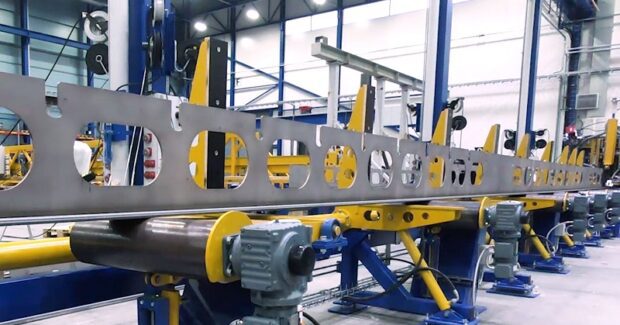T-Beam Production Line Improves Shipbuilding Efficiency
The fully automated PEMA T-beam production line from Pemamek enables high capacity, high quality and geometrically precise T-beams without any post-weld processes so that shipbuilders can improve their overall shipyard profitability and efficiency.
Posted: October 24, 2019
In the rapidly changing shipbuilding industry, competitiveness and productivity must be developed constantly to eliminate every unnecessary work phase and possible bottleneck from the production chain. In shipyard steel manufacturing, the size and shape of the parts play significant role in overall productivity. The goal of advanced flat panel fabrication process is to minimize panel deformations and maximize output of the fabrication line. This requires accuracy in panel fabrication, but above all it requires geometrical precision of welded sub-assemblies, such as T-beams that are later welded to flat panels. When parts are precisely positioned and part compatibility is good, the amount of rework and time used on fitting can be minimized. However, the risk of deformations increases when using higher strength steels and reduced material thicknesses.
In T-beam and web assembly on panel and block lines, deformations of welded T-beams tend to cause a lot of unnecessary rework. Traditional post-weld heat treatment and mechanical straightening processes are used to increase the dimensional accuracy of T-beams and make the beams straighter, but they may also increase or dissolve residual stresses and result in greater deformations that increase the time used for T-beam production. The fully automated PEMA T-beam production line from Pemamek Oy (Loimaa, Finland) tackles these issues so that shipbuilders can improve their overall shipyard profitability and efficiency. Its innovative, integrated welding and deformation control system results in high production output and quality that is dimensionally accurate for panel fabrication and other shipbuilding processes – and is achieved without any post-weld processes.
In the PEMA production line, T-beam fabrication starts from receiving the pre-processed flanges and webs. Flanges are cut to the correct length, ends are shaped and reference markings are placed. Webs are cut to the correct size and shape using a thermal process in the plate pre-fabrication area. A cleaned web edge against the cleaned flange enables high speed and high-quality welding. Cleaning the welding zones ensures that no impurities cause any welding defects and optimum welding process parameters can be utilized. The profile processing line is powered by HGG to clean the flange at the web connection zone and shape the flange ends. Plate cutting stations provide accurate and high-quality webs for T-beam production. A grit blasting unit cleans both edges of the web simultaneously so that straight, cleaned T-beams are delivered for easy and accurate matching of the web and flange. Flanges and webs are gathered to buffer conveyors and, in the assembly station, the web is flipped 90 deg to vertical position and positioned on the corresponding flange.
After positioning the web and flange longitudinally and transversally in correct position according to the correct offsets, the operator ensures the fine adjustments and tack welds the front end of the T-beam. The tail end of the previous T-beam is welded in automatic mode so that the assembly of the next T-beam does not reduce line productivity. Dedicated handling devices guarantee safety and fully controlled positioning of the webs and flanges. A double-sided single GMAW fillet welding process in specific pulse mode is used to obtain wanted features: low heat input, proper penetration and throat thickness, high welding speed and consistent high quality. The deformation control system minimizes T-beam deformations caused by welding. Deformations typically cause longitudinal and transversal shrinkage, angular deformation and bending of the T-beam. Cutouts in the web cause another variable to be taken into account when trying to minimize the deformations. PEMA WeldControl 120 AutoSmart software with weld and heat balance simulation analysis determines the correct heat balancing parameters so that straight and dimensionally accurate symmetrical T-beams are achieved. When T-beams are dimensionally accurate, their assembly is easier and faster, and their quality, overall productivity and post-production value improves.
Pemamek LLC, 20333 State Highway 249, Suite 200, Houston, TX 77070, 513-206-0807 or 214-662-8812, pemamek.com.




